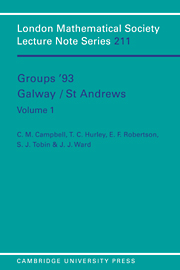Book contents
- Frontmatter
- Contents
- Preface
- Introduction
- Geometry, Steinberg representations and complexity
- The structure of metabelian finite groups
- Table algebras of extended Gagola-type and applications to finite group theory
- On the saturation of formations of finite groups
- Locally constructed formations of finite groups
- Reflections on virtually one-relator groups
- Rickard equivalences and block theory
- Computing the conjugacy classes of elements of a finite group
- Quotient categories of modules over group algebras
- Weak chain conditions for non-almost normal subgroups
- Computation of the character table of affine groups using Fischer matrices
- The lattice of compact representations of an infinite group
- Automorphisms of nilpotent and related groups
- Generation of orthogonal groups over finite fields
- The structure of certain Coxeter groups
- n-free groups and questions about universally free groups
- Classification of all generating pairs of two generator Fuchsian groups
- Parametric words and models of the elementary theory of non-abelian free groups
- The groups G(n, l) as fundamental groups of Seifert fibered homology spheres
- Lifting automorphisms: a survey
- (MI)-groups acting uniserially on a normal subgroup
- Revisiting a theorem of Higman
- Cohomological finiteness conditions
Automorphisms of nilpotent and related groups
Published online by Cambridge University Press: 02 March 2010
- Frontmatter
- Contents
- Preface
- Introduction
- Geometry, Steinberg representations and complexity
- The structure of metabelian finite groups
- Table algebras of extended Gagola-type and applications to finite group theory
- On the saturation of formations of finite groups
- Locally constructed formations of finite groups
- Reflections on virtually one-relator groups
- Rickard equivalences and block theory
- Computing the conjugacy classes of elements of a finite group
- Quotient categories of modules over group algebras
- Weak chain conditions for non-almost normal subgroups
- Computation of the character table of affine groups using Fischer matrices
- The lattice of compact representations of an infinite group
- Automorphisms of nilpotent and related groups
- Generation of orthogonal groups over finite fields
- The structure of certain Coxeter groups
- n-free groups and questions about universally free groups
- Classification of all generating pairs of two generator Fuchsian groups
- Parametric words and models of the elementary theory of non-abelian free groups
- The groups G(n, l) as fundamental groups of Seifert fibered homology spheres
- Lifting automorphisms: a survey
- (MI)-groups acting uniserially on a normal subgroup
- Revisiting a theorem of Higman
- Cohomological finiteness conditions
Summary
Introduction
If G is a group then as usual we denote the automorphism group of G by Aut G. In this paper we give a survey of results concerning Aut G in the case when G is nilpotent or satisfies some generalized form of nilpotency. The first part of the paper will be concerned with the situation in which Aut G is as small as it can be. For each group G we let Z(G) denote the centre of G, although when no ambiguity arises we shall often simply denote Z(G) by Z. As usual we write G′ to denote the derived subgroup of G. Of course, G/Z(G) is isomorphic to Inn G, the group of inner automorphisms of G. In Section 2, we discuss the situation in which Inn G = Aut G. We give rather an old example due to Zaleskii [50] showing that this situation can hold for nilpotent groups and then discuss some consequences.
As usual we denote the factor group Aut G/ Inn G by Out G, the group of outer automorphisms of G. Thus Section 2 is concerned with the situation when Out G = 1. By contrast, in Section 3 we discuss the situation which in a sense is opposite to that of Section 2. In Section 3 we are interested in showing that often Out G is rather large. The discussion is concerned mostly with nilpotent p-groups in Section 3. However we also discuss recent work of Puglisi and some simple consequences.
- Type
- Chapter
- Information
- Groups '93 Galway/St Andrews , pp. 156 - 171Publisher: Cambridge University PressPrint publication year: 1995
- 1
- Cited by



